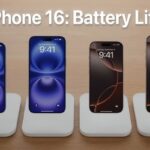rs on a Single Charge?
Battery life has always been a crucial factor for smartphone users, and Apple has consistently worked on improving this with each new iPhone release. The iPhone 15 series already made strides in battery performance, especially in the Pro models, but the iPhone 16 is expected to push this even further.
Larger Battery Capacity
One of the most prominent rumors is that the iPhone 16 will feature a larger battery than its predecessors. This would naturally increase the amount of power available, extending battery life across the board. Reports suggest that Apple is exploring new battery technology that could pack more energy into a smaller physical size, allowing for a larger battery without increasing the thickness of the device.
Power-Efficient A18 Bionic Chip
Another factor that could significantly boost battery life is the A18 Bionic chip, which is expected to power the iPhone 16. Built on an advanced 3nm process, the A18 chip is likely to offer improved performance while consuming less power. A more efficient chip means the iPhone 16 will be able to run demanding tasks without draining the battery as quickly.
Software Optimization
In addition to hardware improvements, Apple is known for optimizing iOS to work efficiently with its hardware. With the release of iOS 18 alongside the iPhone 16, we can expect new power-saving features and better background management, which will help extend battery life without sacrificing performance. Features like adaptive brightness and enhanced app sleep modes could reduce battery drain when the phone is not in use.
2. Faster Charging Speeds: USB-C to the Rescue?
One of the most exciting potential updates to the iPhone 16 is the switch from Apple’s proprietary Lightning port to the universally adopted USB-C. This change could have a major impact on the device’s charging speeds, bringing it in line with competitors that already offer super-fast charging via USB-C.
USB-C and Fast Charging
With the introduction of USB-C, the iPhone 16 could support much faster charging speeds than previous models. USB-C can handle significantly higher power levels, which means that the iPhone 16 might support charging at up to 100 watts or more, compared to the 20-30 watts typically seen on current iPhones.
Faster charging would allow users to quickly top up their phones, potentially getting a 50% charge in just 15-20 minutes. This could be a game-changer for users who need to charge their phones quickly on the go.
GaN Chargers: The Future of Power Bricks
There’s also speculation that Apple may begin offering GaN (Gallium Nitride) chargers as part of the iPhone 16 ecosystem. GaN technology allows for smaller, more efficient power bricks that can deliver higher wattage without overheating. This means users could charge their iPhones faster without the bulky and heavy chargers typically associated with high-wattage charging.
3. Wireless Charging and MagSafe Enhancements
Wireless charging has become a standard feature in iPhones since the iPhone 8, but with the iPhone 16, Apple may introduce significant upgrades to its wireless charging technology. MagSafe, Apple’s magnetic wireless charging system, could see enhancements in both charging speed and efficiency.
Faster Wireless Charging
Currently, MagSafe offers wireless charging at up to 15 watts, which is slower than most wired charging solutions. However, there are rumors that the iPhone 16 may support faster wireless charging speeds, potentially increasing to 20-25 watts. This would make wireless charging a more viable option for users who want the convenience of charging without cables but still need fast results.
Expanded MagSafe Ecosystem
Apple could also expand the MagSafe accessory ecosystem, offering new charging docks, battery packs, and stands that take full advantage of the iPhone 16’s improved wireless charging capabilities. Expect more third-party accessories to follow suit, as USB-C and MagSafe become more prominent in Apple’s device lineup.
advancements.
